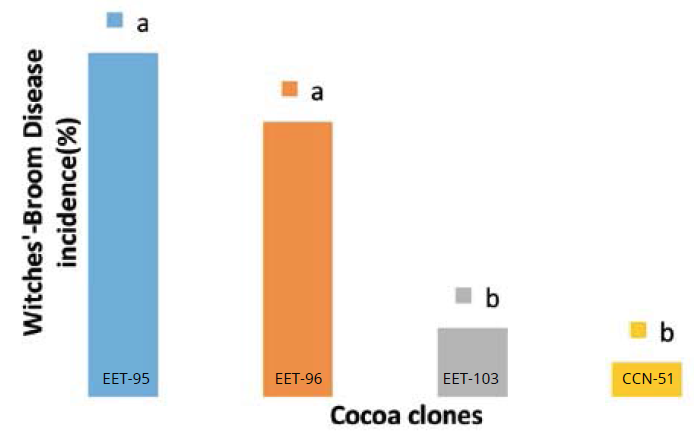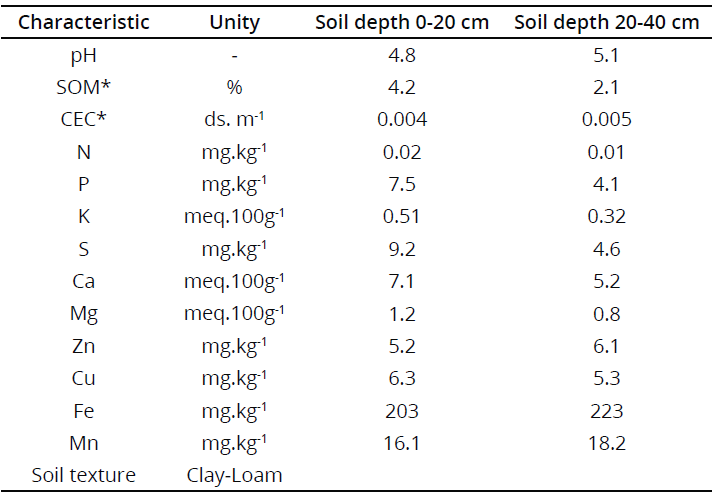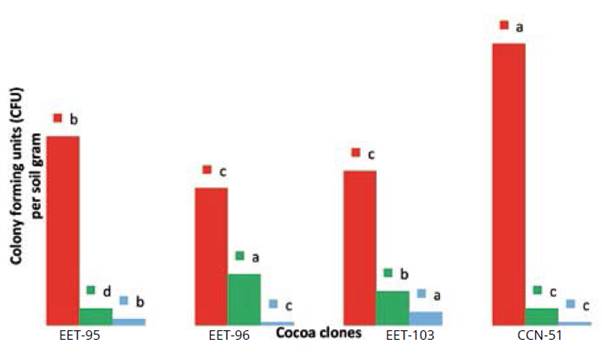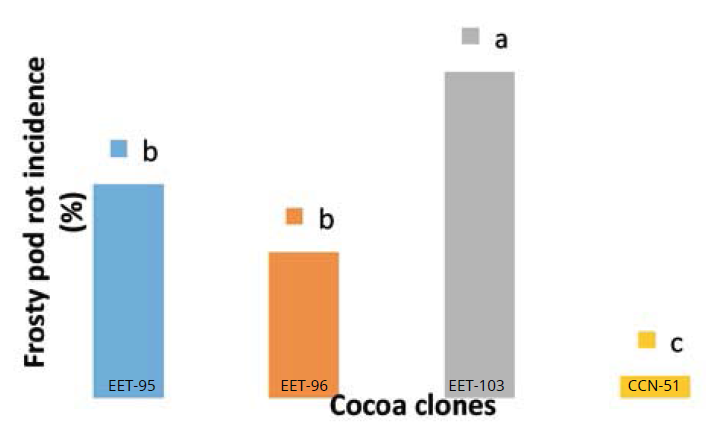Introduction
In 2013, the cocoa (Theobroma cacao L.) world production reached 4.58 million of tons, slightly lower than in 2012. Ecuador produced 128.446 thousands of tons (FAOSTAT, 2015). This fruit has great importance in the food industry, pharmaceutical and cosmetics.
Studies on microorganisms have been developed primarily to determine their amounts in the soil. There is some research which shows that microbial populations are affected by the type of plant species (Soto, Zavala, Pérez & Cargo, 2012; Mano & Mrisaki, 2008; Werner & Newton, 2005). On the other hand, Argüello & Moreno (2014), they pointed out that the cocoa adaptability to adverse conditions is related to the microorganisms associated with the soil rhizosphere and this determines the plant nutrition availability and plant development, in this sense, the plant genetic characteristics are related in some way to the microorganisms presence in the soil rhizosphere of a particular cocoa genotype.
Moniliophthora roreri (Cif.) H. C. Evans, Stalpers, Samson & Benny, causal agent of frosty pod rot (FPR), occurs in the major cacao-producing areas in the western hemisphere. M. roreri, a highly specialized fungus, causing internal and external pod damage that results in total pod loss. The presence of the disease in the cacao tree (Theobroma cacao L.) has had such devastating effects on yield that long-term economic viability of the crops has been compromised (Jaimes, Gonzalez, Rojas, Cornejo, Mideros & Restrepo, 2016; Espinosa-Álzate & Ríos-Osorio, 2016).
In the relationship of the ecosystem with plant species, specific interactions occur that can also be expressed from genotypes of the same species. The case of the study of cocoa genotypes in interaction with soil microorganisms and plant diseases is poorly reviewed. Given these concerns, the aim of this research was to analyze the relationship between soil microorganisms and the major diseases with promising clones of cocoa (Theobroma cacao L.) under the edaphoclimatic conditions of the Ecuadorian Amazon region, in particular in the Arosemena Tola Canton of Napo province, Ecuador.
Materials and methods
Study area
The research was carried out during the years 2012 to 2015 in the Center for Research, Postgraduate and Conservation of the Amazon (CIPCA), located in the Ecuadorian Amazon Region, Napo Province, Arosemena Tola Canton, Ecuador; road to Puyo-Tena Km 44, close to the mouth river of the Piatúa and Anzu rivers, at 527 m.a.s.l., on a soil belonging to the inceptisols order (Soil Survey Staff, 2003), with the physical-chemical characteristics shown in Table 1.
Plant material
Cocoa (Theobroma cacao L.) postures from five-month-old EET-95, EET-96, EET-103 and CCN-51 clones, respectively, were transplanted at a planting distance of 3.5 x 3.5 m. The cocoa plants for the transplant were obtained from a certified nursery, with 12 leaves, stem of 15 mm in diameter and plant height of 40 cm, without pest or disease symptoms, vigorous and homogeneous.
Evaluation of the microorganism groups
For the soil microbiological analysis, a randomized soil samples were taken into the plants rhizosphere, 40 cm from the stem and at a soil depth of 0-20 cm. The soil samples were formed from five sub-samples of 200 g, taken from each treatment (EET-95, EET-96, EET-103 and CCN-51, respectively cocoa clones) and replications. Subsequently, were homogenized and one soil gram was weighed. Serial dilutions were prepared from the dilution of the soil gram in 9 mL of sterile distilled water. Therefore, was vigorously stirred for 5 minutes on a Vortex shaker. This procedure was followed until obtaining a 10-7 dilution.
Microorganisms sowing
Total bacteria. An aliquot of 0.1 mL from 10-6 dilution was placed into the surface center of the culture medium in Petri dishes with 20 mL of nutritive agar. (Triplicate). Subsequently, was placed at room temperature of 30 to 37°C for 24 hours.
Total fungi. An aliquot of 0.1 mL from 10-2 dilution was placed into Petri dishes with 20 mL of papa dextrose agar (PDA), Bengal rose and streptomycin (with the aim to not allow the growth of bacteria) (Triplicate). Subsequently, was placed at room temperature of 28 to 30°C for 7 days.
Total Actinomycetes. An aliquot of 0.1 mL from 10-4 dilution was placed into the Petri dishes with 20 mL of Czapek (Triplicate). Subsequently, was placed at room temperature of 28 to 30°C for 10 days.
In all cases, the dilution was placed into the surface center of the specified culture medium, spread and distributed homogeneously over the entire plate surface with a previously sterilized glass rod (immersed into 70% alcohol), subsequently was passed throughout a flame of the lighter and have allowed to cool. Finally, Petri dishes were placed inverted.
It was observed that, once the time had elapsed at the defined temperature, the colony count was carried out, which was quantified as colony forming units (CFU) per soil gram.
Plant diseases evaluation
The evaluation of the presence of the diseases started from the determination of the percentages of appearance of the same.
Percentage of plant diseases incidence. Data were taken for the use of the criterion adopted by Sánchez, Gamboa & Rincón (2003). The evaluations were carried out in 30 plants per treatment as follows:
% Incidence = Number of affected plants or organs / Total number of plants or organs analyzed x 100.
Number of plants with incidence start of cocoa black pod (Ceratocystis fimbriata, Ellis & Halsted or Ceratocystis cacaofunesta Engelbrecht & Harrington).
Number of cocoa plants with Witches'-Broom Disease (Crinipellis perniciosa Sthael. Singuer).
Number of cocoa beans damaged by frosty pod rot/total cocoa plants (Moniliophthora roreri (Cif & Par) Evans et al.).
Number of cocoa beans damaged by black pod/ total cocoa plants (Phytophthora spp.).
Statistical analysis
The experimental design was a completely block design, the treatments consisted of EET-95, EET-96, EET-103 and CCN-51 cocoa clones. After 2.5 years of establishment of the different cocoa clones, a microbiological characterization and plant diseases associated with the cocoa genotypes under study was carried out.
The statistical data processing was carried out using Statgraphics plus software version 5.0. The adjustment to normal distribution of data from each treatment (Kolmogorov-Smirnov) and the variances homogeneity (Levene), was checked. Subsequently, one-way ANOVA and HSD Tukey test were developed. To identify significant difference among treatments and statistical significance for all comparisons was made at p<0.05. Tukey's multiple range test was used to compare the mean values of treatments. The data in percentages were transformed by 2arcosenVp for its statistical processing.
Results
Characterization of the major groups of microorganisms related to the evaluated cocoa clones
The microbiological analysis have allowed to verify the highest population level of microorganisms, which was reached by the bacteria group, due to highest values, which were presented in the cocoa clones under evaluation and in particular in the clone CCN-51, which showed a higher degree of bacteria presence associated with the rhizosphere of cocoa clones, as seen in Figure 1.
Values expressed with exponent 104. Simple ANOVA. Tukey HSDtest, p<0.05. η = 3 Standard Error: Bacteria (red bar) = 5.41; Actinomycetes (green bar) = 0.26; Fungi (blue bar) = 0.02. Different letters show statistical differences among each microorganisms group.
Among the promising cocoa clones no differences were found, they expressed lower values than the CCN-51 cocoa clone. The actinomycetes group were the second group of microorganisms present and associated with the cocoa clones, which showed results in which the EET-96 and EET-103 cocoa clones reached the highest values. The results regarding fungi, the third microorganisms group in abundance in the rhizosphere of the cocoa clones under evaluation, showed the largest populations were found in the EET-103 cocoa clone.
Incidence of the major diseases present in the evaluated cocoa clones
The evaluation results of the major diseases that attacked cocoa clones are presented below. Although four diseases were evaluated, from the point of view of their incidence, as indicated by Sánchez, Gamboa & Rincón (2003), there was no incidence of Ceratocystis frimbiata Ellis & Halsted or Phytophthora spp., there were no plants with start of Witches'-Broom Disease, black pod and frosty pod rot.
In the Figure 2, the results of the Witches'-Broom Disease incidence (Crinipellis perniciosa Sthael Singer) are shown, EET-95 and EET-96 cocoa clones, showed the highest disease incidence without differing among them, althought they differed with respect to EET-103 and CCN-51 cocoa clones. from the other clones under evaluation, between EET-95 and EET-96 clones no differences were found, these in turn, had achieved differences with respect to CCN-51 clone, which showed the lowest value.

Simple ANOVA Tukey HSD test, p<0.05. Standard Error=2.00. n=30. Different letters show statistical differences among them.
The results referring to the two diseases that affected the cocoa clones under evaluation, showed that the CCN-51 clone is more resistant to disease attack, with respect to the promising clones. For its part, the EET-103 clone, which was less affected by the witch's broom disease, was the one most attacked by frosty pod rot, while the EET-95 and EET-96 clones showed high incidence values of witches' broom disease and frosty pod rot.
These last clones did not present differences among themselves, with the lowest values, even the CCN-51 clone had not achieved any disease incidence.
The results obtained in relation to the disease incidence of Moniliophthora roreri (Cif & Par) Evans et al. (Figure 3), showed a different trend, since the EET-103 cocoa clone was the one which reached the highest value, differentiating itself
Discussion
Characterization of the major microorganism groups related to the evaluated cocoa clones
The fact that a greater quantity of total bacteria was associated to CCN-51 cocoa clone was verified, which showed the specificity of some bacteria groups which were associated with this genotype. In this sense, there are studies that showed the specificity of some types of bacteria showed when interacting, for example, with the roots of tropical Poaceae, in particular the genera Paspalum and Digitaria, where large amounts of nitrogen are fixed.
These bacteria belonged to the genus Azospirillum, Herbaspirillum and Burkholderia, which were found both in the soil rhizosphere and in the intercellular spaces of the root cortex (Mano & Morisaki, 2008).
The roots produce secretions and other rhizopheric compounds that are important sources of C and enter into the soil from the plant, but this phenomenon is not expressed equally in all cocoa genotypes. Diazotrophic bacteria use these resources by associating with the plant roots (Van Loon & Bakker, 2006). In a research carried out by Soto, Zavala, Pérez & Cargo (2012), determined that the microbial populations were affected by the type of plant species, when they determined the total populations of microorganisms in two species as follows: Viguiera dentata (Cav.) Spreng and Ferocaptus latispinus (Haw) Britton & Rose, where a greater bacteria population was expressed and less fungi population in the first and, if not, in the second evaluation.
For this reason, an efficient response is expected, both by the promising clones, those that showed high levels of association for total bacteria, and by the clone CCN-51, which represents a high percentage of its production and export for Ecuador.
Otro ejemplo de asociación de bacterias a una especie concreta es la soya (Glycine max (L.) Merr.), where bacteria of the genus Bradyrhizobium are the major species symbionts. These bacteria, in particular different strains of species such as B. japonicum and B. elkanii, are used as inoculants and in those cases they can contribute between 60% and 90% of the total N used by the plant (Werner & Newton, 2005).
Actinomycetes have been reported as rhizobacteria or plant growth promoting rhizobacteria (PGPR) (Franco, 2009) and this is one of the causes of promising clones showing greater growth.
The fungi group keep together the soil particles, are responsible of an increasing in the soil structural stability and provide food for the soil fauna, which obviously favors this cocoa clone. Some fungi, such as mycorrhizae, form mutualisms with the plant roots and provide limiting nutrients to plants such as P and receive in return C compounds and a free space from competitors (Simard & Durall, 2004).
The soil microbial diversity is fundamental for the maintenance of soil formation, the elimination of toxins and the cycle of elements, diversity measures are increasingly important in the evaluation of soil quality. Examples of rapid changes in the structure of the community could serve as early indicators of changes in soil quality (Gómez, Alkorta, Becerril, Epelde, Anza & Garbisu, 2012; Schimann, Petit-Jean, Guitet, Reis, Domenach & Roggy, 2012).
Contrary to the results obtained in the present study, in a Colombian cocoa plantation (Villamil, Blanco & Viteri, 2012), when evaluating native microorganisms they found almost double the presence of fungi, that of bacteria group.
These same authors determined that there are antagonistic microorganisms that limit the development of frosty pod rot disease both bacteria and fungi.
In any case, the levels of fungi present and associated with the promising EET-103 cocoa clone, many of them native, although in this research only the totals were determined, can affect the presence of this disease.
It was found that soil microbiota associated with the soil rhizosphere of cocoa has specificity, according to the plant genetic characteristics. According to considerations carried out by Argüello & Moreno (2014), the soil microbiota associated with the soil rhizosphere plays a key important role for plant nutrition and plant development, which was demonstrated in the results on the morphoagronomic characterizations carried out on these same cocoa clones by Pérez & Freile (2017).
Incidence of the major diseases present in the evaluated cocoa clones
Taking into account the criteria exposed by Sánchez & Garcés (2012), who pointed out that among the most important cocoa diseases are frosty pod rot (Moniliophthora roreri (Cif & Par) Evans et al.), witches' broom disease ( Moniliophthora perniciosa Aime & Phillips-Mora), black pod (Phytophthora spp.) and in a smaller incidence percentage black pod (machete wilt) (Ceratocystis cacaofunesta Engelbrecht & Harrington), The results obtained in the present research are in correspondence with this assertion, since the greatest disease incidence were for Moniliophthora roreri (Cif & Par) Evans et al. and Moniliophthora perniciosa Aime & Phillips-Mora, without presenting Phythophthora spp., or Ceratocystis cacaofunesta Engelbrecht & Harrington.
In accordance with Bolaños, Vasco, Mercado, Caicedo, Castro, Morales, Castillo & Tezara (2016), frosty pod rot disease is so frequent and so severe that it is considered a disease that constitutes one of the limiting factors in the production of cocoa in America, in particular in Ecuador, has been reported losses ranging from 20 to 80% and such harmful effect is compared with black pod caused by Phythophthora.
It is necessary to emphasize that the clones behaved differently with respect to the disease incidence according to the evaluated cocoa genotype. The results obtained coincide with the criteria of Vasco (2008), which refers to the tolerance of the CCN-51 cocoa clone to these plant diseases and to a lower levels of witch's broom disease and frosty pod rot.
When comparing these results with those obtained by Escobar (2008), in relation to EET-103 cocoa clone, who pointed out that the same clone presents an intermediate incidence of witch's broom disease, owing to his high coincidence, however, this is not the case with EET-96 cocoa clone, which presents low levels of disease incidence, since in the current research, was demonstrated that the ETT-95 and ETT-96 cocoa clones, showed the greatest affectations to witch's broom disease.
Conclusion
Given these concerns, it was found that the bacteria group were the microorganisms with the greatest association to the soil rhizosphere of the evaluated cocoa clones, followed by the group of actinomycetes and fungi. Bearing this in mind, the present research is intended to present the specificity of these microorganisms groups, which were manifested as follows: in CCN-51cocoa clone, the largest number of bacteria, in the EET-96, EET-103 cocoa clones, had achieved a greater representation of actinomycetes and in the EET-103 cocoa clone, the greater fungi presence.
The witch's broom disease (Crinipellis perniciosa Sthael Singer) affected the EET-103 and CCN-51 clones to a lesser extent, while frosty pod rot [Moniliophthora roreri (Cif & Par) Evans et al.] showed that EET-103 cocoa clone, had achieved the highest disease incidence and CCN-51, had achieved the lowest disease incidence.
Conversely, these provides more accurate and reliable estimates of more bacteria were associated in the soil rhizosphere of the cocoa clones under evaluation, the two major diseases that occurred in the study area, were diseases caused by fungi, which were expressed differently in the evaluated cocoa clones and is inferred that there may be antagonistic microorganisms, that in the case of CCN-51cocoa clone, from which a greater number of bacteria were developed, some of them, could perform a decreasing fungus growth and in the case of the EET-103 cocoa clone, the presence of some beneficial fungi can restrict the fungi sporulation and growth, which cause these plant diseases.

















